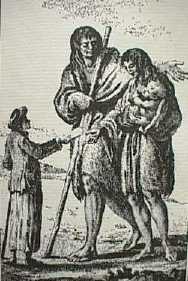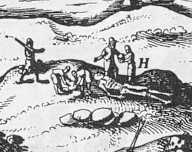The Patagones or Patagonian giants are a mythical race of people, who was believed to live in the region and coastline of Patagonia.
Etymology
Pigafetta (see below) recorded that Magellan had bestowed on these people the name "Patagão" (i.e. "Patagon", or Patagoni in Pigafetta's Italian plural, but did not further elaborate on his reasons for doing so. Since Pigafetta's time the assumption that this derived from pata or foot took hold, and "Patagonia" was interpreted to mean "Land of the Bigfeet". However, this etymology remains questionable, since amongst other things the meaning of the suffix -gon is unclear. Nevertheless, the name "Patagonia" stuck, as did the notion that the local inhabitants were giants. Early maps of the New World afterwards would sometimes attach the label regio gigantum ("region of giants") to the area.
Description/Morphology
Patagones were supposed to have exceeded at least double normal human height, some accounts giving heights of 12 to 15 feet or more.
History/Sightings
First mention of these people came from the voyage of Ferdinand Magellan and his crew, who claimed to have seen them while exploring the coastline of South America en route to their circumnavigation of the world in the 1520s. Magellan never committed to paper his account of his voyage , as he was killed in Battle in the Philippines, long before his ship returned to Europe. Magellan`s encounter with the Patagonian giants was recorded by his on-board chronicler Antonio Pigafetta, a Venetian nobleman who was a Knight of Rhodes and one of only 18 survivors who sailed around the world on the Magellan 5 ship expedition in 1519. Pigafetta`s diary was published in Italian, French, Spanish, and later into English. It influenced the writings of Shakespeare, Baudelaire, and Poe. Shakespeare based his character Caliban in "The Tempest" on Pigafetta`s account of the Patagonian giant.
"...Leaving that place, we finally reached 49 and one-half degrees toward the Antarctic Pole. As it was winter, the ships entered a safe port to winter. We passed two months in that place without seeing anyone. One day we suddenly saw a naked man of giant stature on the shore of the port, dancing, singing, and throwing dust on his head. The captain-general sent one of our men to the giant so that he might perform the same actions as a sign of peace. Having done that, the man led the giant to an islet where the captain-general was waiting. When the giant was in the captain-general’s and our presence he marveled greatly, and made signs with one finger raised upward, believing that we had come from the sky. He was so tall that we reached only to his waist, and he was well proportioned. His face was large and painted red all over, while about his eyes he was painted yellow; and he had two hearts painted on the middle of his cheeks. His scanty hair was painted white. He was dressed in the skins of animals skillfully sewn together. That animal has a head and ears as large as those of a mule, a neck and body like those of a camel, the legs of a deer, and the tail of a horse, like which it neighs, and that land has very many of them. His feet were shod with the same kind of skins which covered his feet in the manner of shoes. In his hand he carried a short, heavy bow, with a cord somewhat thicker than those of the lute, and made from the intestines of the same animal, and a bundle of rather short cane arrows feathered like ours, and with points of white and black flint stones in the manner of Turkish arrows, instead of iron. Those points were fashioned by means of another stone."
"Magellan's Voyage : A Narrative Account of the First Circumnavigation"
These giants are next mentioned in an account of a voyage round the world, by Sir Thomas Cavendish .
"Sailing from Cape Frio, in the Brasils, they fell in upon the coast of America, in 47 d. 20 m. North (it should be South) latitude. They proceeded to Port Desire, in latitude 50. Here the Savages wounded two of the company with their arrows, which are made of cane, headed with flints. A wild and rude sort of creatures they were; and, as it seemed, of a gigantic race, the measure of one of their feet being 18 inches in length, which, reckoning by the usual proportion, will give about 7 feet and an half for their stature.
In 1578, Sir Francis Drake's ship chaplain, Francis Fletcher, also wrote a manuscript that described meeting very tall Patagonians.
In the 1590s, Anthonie Knivet, who had sailed with Sir Thomas Cavendish, claimed that he had seen dead bodies in Patagonia measuring over twelve feet in length.
In 1579, Sir Francis Drake's ship chaplain, Francis Fletcher, wrote about meeting very tall Patagonians.
Captains Cooke also wrote in his ship's logs of a race of giants that inhabited Patagonia. He even claimed to have captured one of the giants , Unfortunately, the giant escaped by breaking the ropes that bound him to the mast and jumped off the ship, overboard into the sea.
An excerpt from Charles Debrosses’ Historie des navigations aux terres australes, published in 1756, contributed to the giant saga:
"The coast of Port Desire is inhabited by giants fifteen to sixteen palms high. I have myself measured the footprint of one of them on the riverbank, which was four times longer than one of ours. I have also measured the corpses of two men recently buried by the river, which were fourteen spans long. Three of our men, who were later taken by the Spanish on the coast of Brazil, assured me that one day on the other side of the coast they had to sail out to sea because the giants started throwing great blocks of stone of astonishing size from the beach right at their boat. In Brazil I saw one of these giants which Alonso Díaz had captured at Port Saint Julien: he was just a boy but was already thirteen spans tall. These people go about naked and have long hair; the one I saw in Brazil was healthy-looking and well proportioned for his height. I can say nothing about his habits, not having spent any time with him, but the Portuguese tell me that he is no better than the other cannibals along the coast of La Plata."
In 1766 the Dolphin, a ship commanded by Commodore John Byron (nicknamed "Foul-Weather Jack" and grandfather of the poet Byron) returned to London from circumnavigating the globe. While it lay in dock, a rumor leaked out that the crew of the Dolphin had encountered a tribe of nine-foot giants in Patagonia, South America. This rumor first appeared in print on May 9, 1766 in the Gentleman's Magazine. Other newspapers, such as the London Chronicle, then picked up the story.
The 1766 report of Patagonian giants did encounter some initial skepticism. The Journal Encyclopedique printed a letter from M. De La Condamine arguing that the report was a hoax spread by the English in order to camouflage their real motive in sending another expedition to Argentina, which was to exploit a mine recently discovered there. Horace Walpole also wrote a satirical piece titled An Account of the Geantz recently discovered, addressed to a friend, in which he suggested that Byron should have sent some of the Patagonian women back home to England in order to be used to improve the English breed. Despite these notes of skepticism, widespread belief in the rumor persisted.
The rumors of Patagonian giants were only definitively proven to be fictitious when the official account of Byron's voyage appeared in 1773. This account revealed that Byron had indeed encountered a tribe of Patagonians, but that the tallest among them measured only 6 feet 6 inches. In other words, they were tall, but not 12 foot giants. The tribe that Byron met was probably the Tehuelches, who were wiped out by the Rocca expedition in 1880.
The Two-headed Patagonian Giant
“The Two-headed Patagonian Giant” was a famous fairground attraction measuring 12ft (3.7m) tall allegedly brought to England in the 19th century. The story was that he had been captured by Spanish sailors in 1673 and bound to the mainmast of the ship. He broke loose and killed four of his captors, before being killed himself by a boarding pike plunged into his heart.
In the early 1900s, the stuffed giant was purchased by a Mr Bartram who toured the country on the Edwardian horror circuit, ending up in Weston-super-Mare in Somerset, where the curiosity passed through several hands and was exhibited at various locations. It was known as Kap Dwa, which translates approximately as Two-Heads. (In the Malay language, kepala means head and dua means two; how this relates to the supposed Patagonian provenance is unknown.)
It was later sold to a showman called “Lord” Thomas Howard in 1959, after which it left Weston for Blackpool. In the nineties, Billy Hill bought the giant from Howard in Blackpool and, though semi-retired, still toured in his white bus with an assortment of attractions – including a two-headed boy, “the smallest woman who ever lived”, a six-legged lamb, and a three-eyed fox.
The last times it was seen, the two-headed giant was in a glass case with a coiled snake at a travelling funfair in Manchester in November 1998 Newcastle in September 1999.
Theories and analysis
Giant human bones were discovered in Peru as well as in Patagonia. South American legends speak of several giant tribal races, such as the Chancas or Chanak of Peru, which are said to be 7 feet tall on average with red hair.


